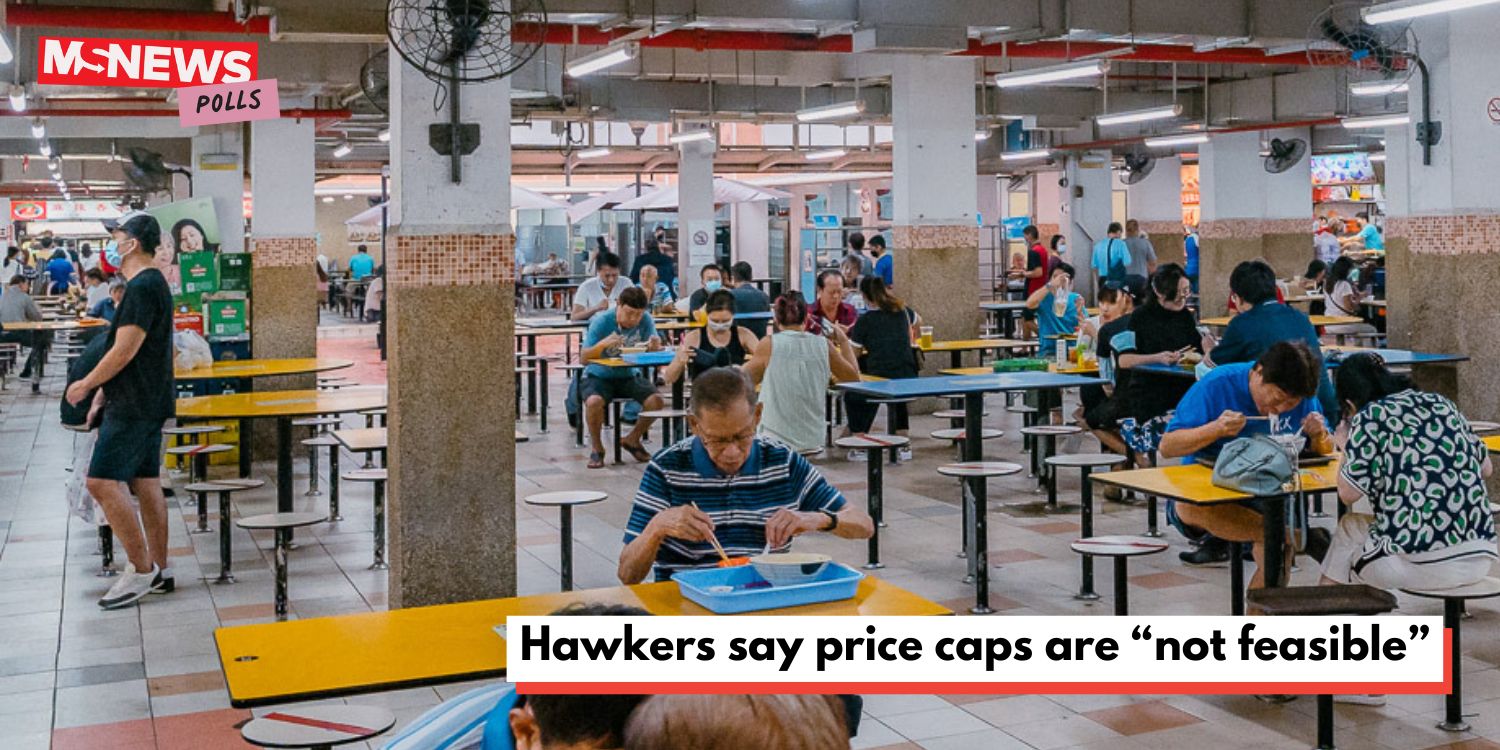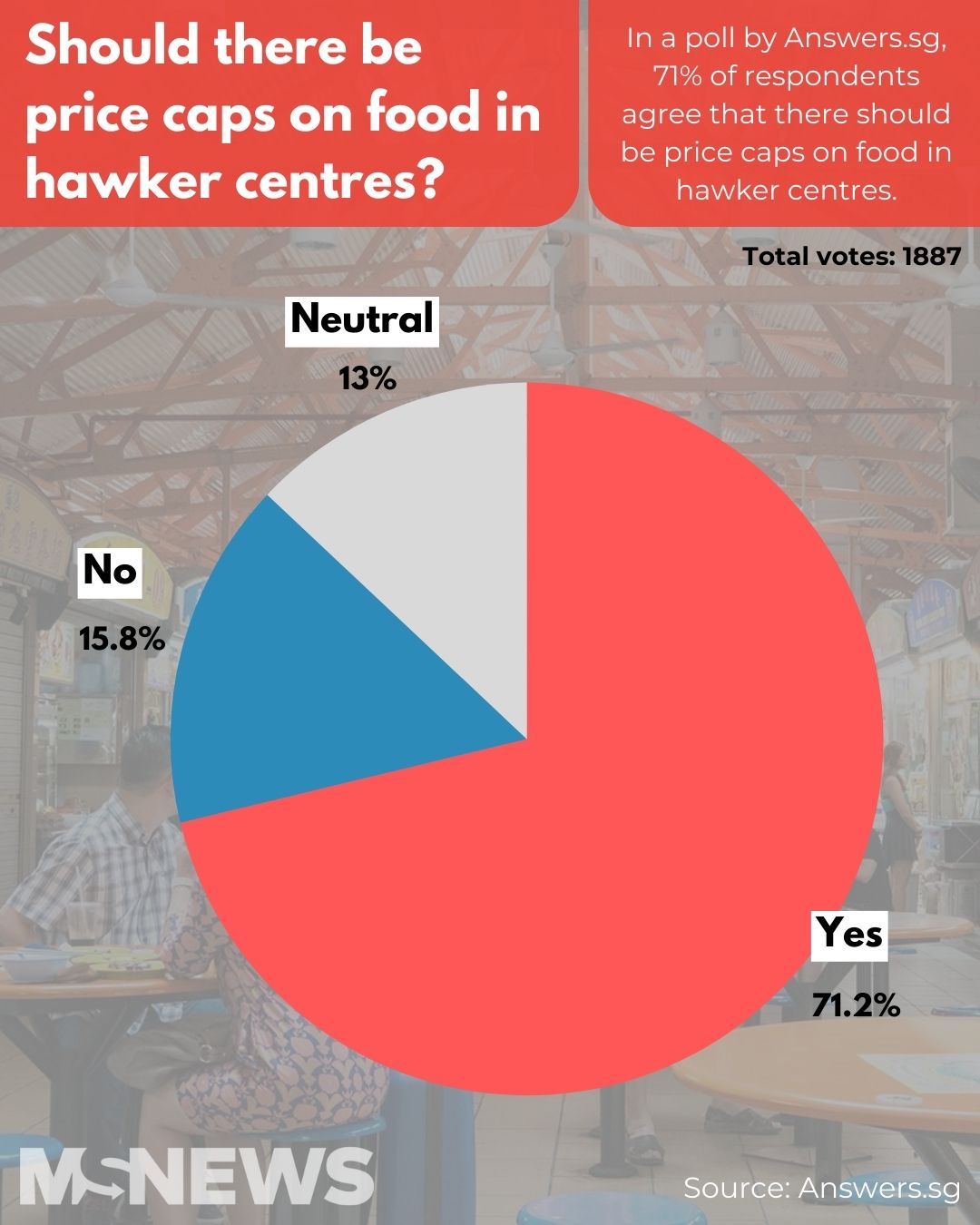- Joined
- Aug 20, 2022
- Messages
- 17,179
- Points
- 113
MS Polls: Is hawker centre food getting too expensive? 71% of respondents ask for price caps

FEATURED LATEST NEWS MS POLLS SINGAPORE
Despite rising costs, hawker centres are still an essential part of livelihood for many Singaporeans.
By Trixy Toh - 10 Apr 2025, 11:31 am
Are hawker centre prices getting out of hand?
According to the Singapore Department of Statistics, hawker food prices rose by 6.1% in 2023 – surpassing the 5.7% in 2022.
As high cost of living continue to plague Singaporeans, many rely on hawker food to remain affordable.
In a poll on Answers.sg with 1,887 respondents, 71% voted that food at hawker centres should have price caps.

Singaporeans say hawker centres are getting more expensive
Hawker centres are a vital part of Singapore’s culture and an essential part of most people’s lives.In 2020, the hawker culture in Singapore was officially inscribed into the UNESCO Representative List of the Intangible Cultural Heritage of Humanity.
They reflect our heritage and celebrate multiculturalism, while also being Singaporeans’ go-to options for affordable food.
This is certainly the case for 26-year-old J. Tay, who is a regular patron of the coffeeshop near his HDB home.
Noting the results of the poll, he told MS News that price caps “sound reasonable”.
Mr Tay noted that a bowl of fishball noodles at the coffeeshop has risen to “S$4 or more”, compared to S$3 just a few years back.
With price caps, stores will have a limit to how much they can charge a customer for their food — especially for simple hawker fare such as rice, noodles, or even kaya toast and coffee.
Netizens were outraged when popular food chain Toast Box increased the price of one of their sets to S$7.40 in August last year.
In an earlier poll on Answers.sg, majority of the 7,425 respondents said that they would not pay more than S$5 on such a meal, indicating that customers do have thresholds when it comes to such food items.
When asked if she would pay S$8 for a plate of Hokkien mee, 24-year-old A. Chua said, “only if it’s a larger sized portion. But if the prices increase by about 15 per cent, then I would reconsider.”
Hawkers say price caps are ‘not feasible’
Even so, hawkers argue that price caps are not feasible.Mentai-Ya, a local food chain with several stalls located in coffeeshops across Singapore selling quality Japanese food at affordable prices, is one such example.
“Prices for different cuisines are different,” said a spokesperson to MS News.
For Mentai-Ya, their supply costs are “typically higher than normal” as they deal with Japanese import goods.
Meanwhile, other stalls may have a lower supply cost depending on what food they serve.
Mentai-Ya has openly shared about the challenges of running hawker or coffeeshop stalls in Singapore.
Within three years, the business has shrunk from 10 stalls to four, due to various reasons including rental prices, the GST hike, and manpower.
“It is really tough to run an F&B business now as rental costs are crazily high,” added the spokesperson.
In response to MS News‘ queries, Mentai-Ya said that they have relocated or exited coffeeshops because of increased rental costs which have soared above S$5,000.
When it increased its food prices by S$1 to account for the increasing costs, the business reported a loss of 20 to 30% of their customers.
More hawkers struggling to make a living
Noorman Mubarak, the owner of the Nasi Lemak Ayam Taliwang stall at Yishun Park hawker centre, believes that the idea of price caps is too simplistic.He argues that price caps would artificially depress prices, and affect salaries, quality, and quantity of hawker food.
Should there be price caps on the customers’ side, every other component involved in preparing the dishes should be capped too, he said.
These include rental, utilities, and salaries of workers.
Mr Noorman shared that it is difficult being a hawker in Singapore now as people are still expecting cheap, pre-Covid prices amid inflation.
He notes that raw food costs have “increased by 50 to 300 per cent”. Recently, the price of coconut cream has increased by 25 per cent.
“Hawkers bear the brunt [of all these challenges],” said Mr Noorman.
Long working hours coupled with minute chances of success and expansion also discourage young Singaporeans from joining the trade.
He added that “local food will not be so local anymore. You can already see many Chinese, China cuisines. More will join in.”
Mr Noorman revealed that only seven out of the 40 original hawkers remain since Yishun Park hawker centre opened in 2017.
“The 33 stalls have changed ownership two to five times. In April this year, three more young hawkers will close their stalls due to poor sales and high handedness of policy implementation,” he said.
Mr Noorman believes that a “radical and fresh intake of ideas need to be discussed and implemented” and hawkers should be a part of this discussion.
While price caps are reasonable, increased hawker prices ‘makes sense’
Mr Tay, who agreed that hawker centres are getting more expensive, also acknowledged that such an increase is unavoidable.“The price of everything is going up, so hawker prices going up makes sense,” said the 26-year-old.
He understands that if hawkers have to raise their prices to make a living, it is the responsibility of the government to step in.
“So maybe applying a limit on rental for hawkers might be a better idea,” said Mr Tay.
Speaking to MS News, Ms Chua thinks that it is a “natural process of inflation that everything increases in price.”
Like Mr Tay, she noted that the government would have to “cover the gap or our hawker stalls will never survive price caps.”
It is true — as Singapore hawkers are certainly struggling with the rising costs here.
The Singapore Department of Statistics revealed common food items such as economical rice, chicken rice, fishball noodles, coffee, and tea are driving the price increases.
Hawker centres remain an essential part of life in Singapore
Amid inflation and increased food prices, hawker centres continue to play an essential role for many in Singapore.Ms Chua frequents hawker centres and food courts and believes they are a “quintessential part of Singapore’s culture.”
“As someone who doesn’t have a family member cooking meals for me, it’s an essential part of my life. So I think hawker food is still the way to go for daily meals,” she said.
Mr Tay, a regular hawker centre patron as well, said that the increased prices have not affected the frequency of his visits.
He added: “Cooking at home is not that cheap anymore, not to mention the time needed to prepare and cook. If I don’t eat at hawker centres, where else would I eat?”



